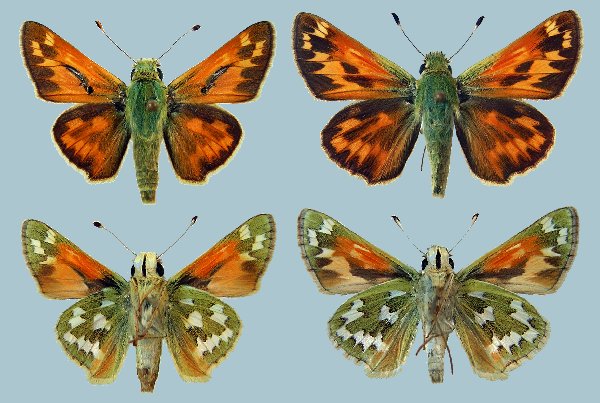Hesperia juba

Photo Life History: Hesperia juba
Habitat: Mountain Canyons; Pinyon Juniper; Agricultural Areas; Valley Wet Meadows; Desert Hills & Mountains; Urban-Suburban
Host Plants: Poa pratensis; Bouteloua gracilis
Suitable Lab Host Plants: Bromus inermus; Phalaris arundinacea; Pennisetum spp. (Most any bunch grass or wide-bladed grass will serve as larval host plants in the lab.)
Caring for Live Female Butterflies: Nectaring techniques
Methods of Female Oviposition: Portable Cages. Getting eggs from females is by far the most productive method of rearing this or any hesperine skippers that belong to the genera Hesperia, Polites, Pseudocopaeodes, Atalopedes, and Hylephila.
How to Find Eggs:
How to Hatch Eggs: Consolidate eggs into one container.
How to Find Caterpillars in the Field: Extremely difficult as larvae construct nests either at the base of bunch grasses or partially below the surface. Again the best way to obtain caterpillars is to collect live females and get eggs.
Caterpillar setups: Open terrarium or potted plant. (If you dig up most any species of bunch grass from disturbed areas, the chances are larvae will accept them.)
Larva to Pupa: Last instar caterpillars pupate right in their nests.
How to Find Pupae in the Field:
Number of Broods per Year: 2-3; depending upon location.
Overwintering Stage: Late instar in the lower mountain canyons; mid-instar in valley floor locations of Utah. (Canyon populations fly in late April whereas valley floor populations fly in late May.)
Overwintering Strategies: Your Own Backyard. (Expose larvae to consistent humidity and airflow.)
Post-Hibernation Strategies: Provide post-diapause third instar caterpillars to healthy host plant.
Avoiding Diapause Techniques: Again, provide larvae with healthy host plant and they will not diapause.
Disease Prevention: Not necessary for potted plant technique. Change out host plant and remove frass every five to seven days using the open terrarium technique.
Emergence: Emergence Container
Field Notes: The flights of this skipper seems counter-intuitive as canyon populations fly before valley floor locations along the Wasatch Front in Northern Utah.

